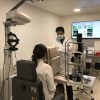
What are refractive errors?
Refractive errors (ametropia) refer to situations in which, due to an optical defect, the quality of vision is not good.
Refractive errors are very common problems in children and include: myopia (poor distance vision), hyperopia (poor near vision), and astigmatism (distorted vision, both far and near). The early detection of these refractive errors is essential to avoid problems of amblyopia (lazy eye).
Diagnosis
The diagnosis of refractive errors is made through a complete ophthalmological examination, placing special emphasis on visual acuity, refraction, anterior segment of the eye, study of the fundus, and detection of a possible strabismus.
Myopia
What is it?
It is the visual problem with the highest prevalence in the world and, due to new habits (working with screens) its prevalence is increasing. The image of the objects is formed in front of the retina. Nearby objects are perceived clearly, while distant objects are perceived in a blurry way.
Can myopia be prevented?
Performing activities outdoors, on a regular basis, during the day can prevent the onset or progression of myopia. The abuse of the use of screens (computers, tablets, and mobile phones) can favor the onset of myopia (Focusing on close objects in a sustained way can make it difficult to see distant objects).
Treatment
The first approach to the therapeutic management of myopia is the use of corrective lenses, either glasses or contact lenses. Glasses are usually well tolerated by the child. Contact lenses are not usually prescribed until the child is mature enough to handle them. Only in special cases, such as high unilateral ametropia, are contact lenses prescribed at early ages (to avoid amblyopia).
A promising treatment for childhood myopia is the use of low-dose atropine eye drops (0.01 percent concentration). Therapy with atropine eye drops is a treatment that should be considered in the medium-long term (minimum 2 years). In the event of a good response (progression <0.5 diopters in two years), the treatment can be withdrawn. In patients with a moderate response (progression> 0.5 ≤1 diopter), treatment should be continued for another two years and evaluated. There are cases where the response is not positive (progression> 1 diopter in two years), in those cases the strategy would be to suspend treatment. In those cases where a good response or a moderate response has been obtained, it is necessary to review the patient one year after the treatment is withdrawn and, if a regrowth occurs, consider retreatment and follow-up.
Hyperopia
What is it?
Hyperopia (farsightedness), is a refractive error, which means that the eye does not bend or refract light properly to a single focus to see images clearly. In hyperopia, distant objects look somewhat clear, but close objects appear more blurred.
It is the most frequent ametropia in childhood. When the eye is at rest, the image of objects is formed behind the retina.
In general terms, the vision of the hyperopic child is good (except for large refractive errors), but based on maintaining a sustained visual effort, which translates into visual effort.
Symptoms
When hyperopia is low (<3 diopters), the hyperopic child sees well, but tires with sustained visual effort. When farsightedness is high, the main symptom will be blurred vision, especially at close distances, the child will move objects away to improve their vision. The disorder is aggravated by continued activity, especially at close range.
The clinical manifestations of hyperopia will depend on the degree of it, it can be asymptomatic if the defect is mild and the child has good accommodation capacity. When farsightedness is greater, the symptoms will be those corresponding to that accommodative effort: headaches, red eyes, poor school performance, tearing, intolerance to light (photophobia).
Treatment
Hyperopia can be easily corrected with glasses or contact lenses.
Astigmatism
What is it?
Astigmatism is an ocular defect characterized by a different refraction between two ocular meridians, which prevents clear focus of objects. Generally, it is due to an alteration in the anterior curvature of the cornea.
There are three basic types of astigmatism: hyperopic, myopic, and mixed. It can exist isolated or associated with myopia or hyperopia.
Symptoms
The main symptom is a decrease in visual acuity, mainly in cases of high astigmatism. The accommodative effort of patients not adequately corrected leads to visual fatigue or asthenopia. Other symptoms include headache, frequent blinking, eye redness, and poor school performance.
Treatment
Mild or moderate astigmatism can be corrected with glasses or contact lenses. Some years ago, the only contact lenses indicated for the correction of astigmatism were rigid ones. Currently, there are soft contact lenses (called toric contact lenses) that can correct astigmatism.

